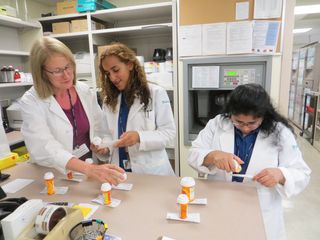“Drugs don’t work in patients who don’t take them.” — C. Everett Koop, MD
 Medication non-adherence -– ie, not taking essential medications or not taking them as prescribed -– can lead to serious outcomes and, as a result, readmissions to hospitals. Indeed, in this country, nearly one in five hospital readmissions is related to medication issues.
Medication non-adherence -– ie, not taking essential medications or not taking them as prescribed -– can lead to serious outcomes and, as a result, readmissions to hospitals. Indeed, in this country, nearly one in five hospital readmissions is related to medication issues.
The reasons for not taking medications vary, but frequently result from either a patient’s lack of understanding about the medication or an inability to obtain the drug. This is especially true in patients with diseases that require complicated medication regimens. A recent Penn study investigated the barriers to medication adherence in patients with HIV as well as ways to overcome these obstacles. Another Penn study focused on this problem in patients with chronic Hepatitis C.
Now, a new program at the Hospital of the University of Pennsylvania has the potential to significantly reduce these occurrences. MyPennPhamacy delivers prescribed medications to inpatients at the time of discharge, eliminating the need to stop at the local pharmacy on the way home and ensuring that the patient not only has the correct medication but also understands how to use it.
The MyPennPharmacy staff comprises a dedicated pharmacist who works with two technicians and a billing coordinator to ensure that the correct prescriptions are delivered to the correct patient, prior to discharge. Launched in April, the program is currently being piloted on four of HUP’s inpatient units.
Working with the unit-based pharmacist -– as well as with nurses, social workers and other health-care providers on the unit -- the MPP technician identifies patients who may be eligible to participate, based on specific criteria. The tech then explains the program to these patients. If they’re interested in participating, a special icon appears next to the patient’s name on Navicare, the hospital’s electronic patient-flow system. This immediately notifies the MPP pharmacist as well as the staff on the unit as to which patients are now part of the program.
When the participating patient nears discharge, the unit-based pharmacist completes the final medication reconciliation, making sure all medications are accurate and coincide with the discharge document. Then the MPP tech enters the prescriptions into the pharmacy’s billing system where the prescriptions are processed and billed to the patient’s prescription drug insurance policy. Once the prescriptions are reviewed and filled by the MPP pharmacist, the tech delivers them to the patient and collects the patient’s co-payment at bedside. The unit-based pharmacist then performs the final step in this process: educating the patient about each prescription and answering questions.
Timing is important. “It’s very patient-centered. We will not delay a patient’s discharge,” said Donna Capozzi, PharmD, associate director of Ambulatory Services.
The idea for this program came from Penn Medicine's ‘Big Idea’ competition to improve patient satisfaction, and, based on informal feedback from patients, the program is a success:
- “I love how convenient this is. I can go straight home and sleep.
- “All the convenience of my pharmacy and you bring it up to my room? How great is this.”
“Our goal is to make this program accessible to as many patients as possible,” Capozzi said. In addition to expanding to other inpatient units, she said that MPP could also help outpatient cancer patients, bringing medications for pain or nausea during the course of the treatment.
“This program can truly have an impact on readmissions,” she said. “It’s a win-win situation for both our patients and the hospital.”
Photo: (L. to r.): Members of the MyPennPharmacy team include pharmacist Jane Sensenbrenner and pharmacy techs Fransheca Soto and Smitha Jacob.